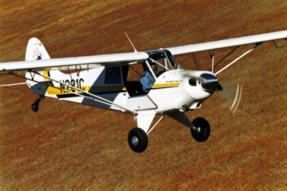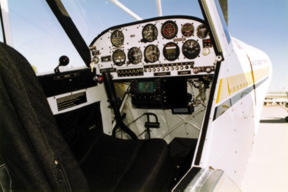|
|
 |
| Interested in an aviation-related book? Find it at... |
|
|
|
|
SW Aviator Magazine
|
3909 Central NE
Albuquerque, NM 87108
Phone: 505.256.7031
Fax: 505.256.3172 |
| publisher@swaviator.com |
|
| Call of the Wild - The Aviat Husky |
| story by Kevin McKown, photos by Don Mickey |
In early aviation most aircraft were light, rugged, tail wheel or float-equipped machines, able to land on short rough airstrips or in any farmer’s pasture. One hallmark of these early landing sites was a lack of creature comforts, like a motel a nd courtesy car, so camping out under the wing of your Piper Cub at the end of a long flying day was just a necessary part of the routine. Consequently, in the early days of aviation most folks dismissed pilots as just crazy folks, using their newfangled flying machines for free-spirited fun and adventure. nd courtesy car, so camping out under the wing of your Piper Cub at the end of a long flying day was just a necessary part of the routine. Consequently, in the early days of aviation most folks dismissed pilots as just crazy folks, using their newfangled flying machines for free-spirited fun and adventure.
Aviation today is more civilized. We pilots now fly docile tricycle gear aircraft, landing on a mile of wide, smooth concrete with a Hilton or Marriott conveniently located just behind the FBO. But somewhere, lurking deep within each of us, is that same romantic, free-spirited pilot, looking to escape civilization’s cage. Fortunately, there is still a descendant of that old, rugged Piper Cub that can set you free — Aviat’s Husky.
Back country flying is unique in that it sharpens the skills that most of us learned, but may have lost. For me, there is nothing so exhilarating as a planned off-airport landing. Imagine, a small dirt road or grassy meadow by the lake that you’ve now dubbed your landing spot. A couple of low and slow passes to ensure wing clearance, terrain texture, and possible animal interference, and you’re ready to land. After an approach at a speed that seemed no faster than a brisk walk, you plop it onto the intended touchdown spot. A few bounces over ruts and abandoned prairie dog mounds later, you hop out into the fresh air and survey your new domain. Free at last!

The typical aircraft for this kind of escape needs to be stout, slow-landing, with hang-from-the-prop performance. Will these characteristics compromise cruise performance? Sure, everything we fly has a compromise, but the idea behind a good bush plane is to lessen that compromise as much as possible. The Husky seems to excel in that ability.
I have owned a couple of Piper Cubs through the years, so it was interesting for me to make a few comparisons with the new Husky. I was surprised to note the Husky has a slower approach speed than my old Cub, and the hang-from-the-prop power of the Husky leaves the Cub in the trees. The Husky climbs like a bush plane should. Had my Cub had that kind of climb, I may have put down in a few  tighter spots. The slow flight handling of the Husky feels much more stable than that of the Cub, and ground roll is a little easier to manage. The landing gear seems as rugged as the old Piper. I was glad to see payload and storage room has increased dramatically, since the modern back country pilot might want to take along more than just the family dog. tighter spots. The slow flight handling of the Husky feels much more stable than that of the Cub, and ground roll is a little easier to manage. The landing gear seems as rugged as the old Piper. I was glad to see payload and storage room has increased dramatically, since the modern back country pilot might want to take along more than just the family dog.
The new Aviat Husky offers the same freedom as its predecessor, and has minimized the compromises. So if the routine of practical, modern flying has you feeling a little caged, consider setting yourself free in a true a back country airplane. Heed the call of the wild. The new Husky might just be the right key to unlocking your free spirit.
|
|
HUSKY A-1A
Engine
Horsepower
Prop
Length
Wingspan
Wing Area
Wing Loading
Power Loading
Empty Weight
Gross Weight
Gross Weight - Floats
Fuel Capacity
Useful Load
Useful Load - Floats
Cargo capacity
Seats
Max Speed
Cruise - 75%
Cruise - 55%
Stall w/flaps (power off)
Stall w/flaps (power on)
Landing Speed
Flaps Extend Speed
Takeoff Distance
Landing Distance
Rate of Climb
Service Ceiling
Fuel Consumption - 55%
Range - 55%
|
SPECS
LYC O-360 A1P
180
2-Blade Constant Speed
22 feet 7 inches
35 feet six inches
183 square feet
10.3 lbs/square foot
10.5 lbs / hp
1190 lbs.
1890 lbs
2170 lbs
52 gallons (50 gallons usable)
700 lbs
800 lbs
10 cu feet, 50 lbs
2 in tandem
145 mph / 126 kts
139 mph / 121 kts
130 mph / 113 kts
42 mph / 36 kts
33 mph / 29 kts
48 mph / 42 kts
80 mph / 69 kts
200 feet
350 feet
1,500 FPM
20,000 feet MSL
7.7 GPH
800 miles |
|
|
|
| Click here to return to the beginning of this article. |
The material in this publication is for advisory information only and should not be relied upon for navigation, maintenance or flight techniques. SW Regional Publishing, Inc. and the staff neither assume any responsibilty for the accuracy of this publication's content nor any liability arising out of it. Fly safe.
|
|
|
|

